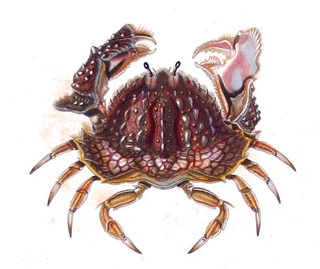
Calappa hepatica, the reef box crab, is a common benthic species of box crab of tropical and subtropical parts of the Indian and Pacific Oceans and the Red Sea.
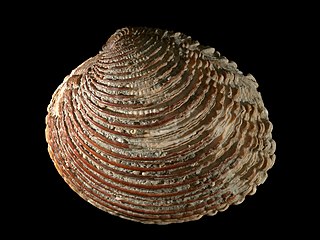
The Veneridae or venerids, common name: venus clams, are a very large family of minute to large, saltwater clams, marine bivalve molluscs. Over 500 living species of venerid bivalves are known, most of which are edible, and many of which are exploited as food sources.
Laternulidae, common name lantern clams, is a family of saltwater clams, marine bivalve molluscs in the order Anomalodesmata.
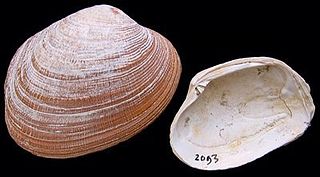
The grooved carpet shell, or Palourde clam, Ruditapes decussatus, or Venerupis decussatus, is a clam in the family Veneridae. It is distributed worldwide and due to its ecological and economic interest has been proposed as a bioindicator.

Mya truncata, common name the blunt gaper or truncate softshell, is a species of edible saltwater clam, a marine bivalve mollusk in the family Myidae.

Chamelea gallina is a species of small saltwater clam, a marine bivalve in the family Veneridae, the venus clams.
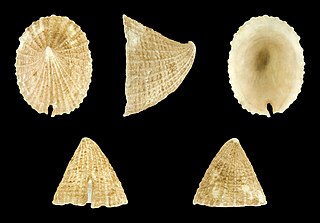
Emarginula fissura, the common slit limpet, is a species of sea snail, a marine gastropod mollusk in the family Fissurellidae, the keyhole limpets.

Phalium, common name the bonnet shells, is a genus of large sea snails, marine gastropod molluscs in the family Cassidae, the helmet shells, bonnet shells and their allies.

Pteria colymbus, the Atlantic winged oyster, is a species of bivalve mollusc in the family Pteriidae. It can be found along the Atlantic coast of North America, ranging from North Carolina to Bermuda and Brazil.

Venerupis is a genus of marine bivalve molluscs in the family Veneridae commonly known as carpet shells. The valves are robust and rhomboidal with the umbones turned-in and nearer the anterior end. The posterior end is wedge-shaped and the internal margins of the valves are smooth. There are 3 or 4 cardinal teeth on each valve. The foot is large and the siphons are of medium length and united except at the very tip.
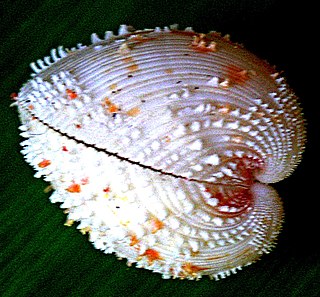
Fragum unedo is a species of cockle, a marine bivalve mollusc in the family Cardiidae, commonly known as the Pacific strawberry cockle. It is found in tropical seas in the Indo-Pacific region and the empty shells are prized for use in decorative crafts.

Thracia convexa is a bivalve mollusc in the family Thraciidae.

Hermes is a subgenus of sea snails, marine gastropod mollusks in the family Conidae, the cone snails and their allies.
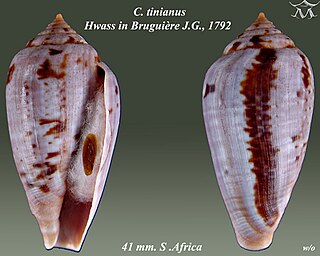
Ketyconus is a synonym of the subgenus Conus (Floraconus)Iredale, 1930 represented as ConusLinnaeus, 1758. These are sea snails, marine gastropod mollusks in the family Conidae, the cone snails and their allies.

Lamniconus is a subgenus of sea snails, marine gastropod mollusks in the family Conidae, the cone snails and their allies.

Lautoconus is a subgenus of sea snails, marine gastropod mollusks in the genus Conus, family Conidae, the cone snails and their allies.

Plicaustraconus is a subgenus of sea snails, marine gastropod mollusks in the genus Conus, family Conidae, the cone snails and their allies.

Venerupis corrugata, the pullet carpet shell, is a species of bivalve mollusc in the family Veneridae. It is found buried in the sediment on the sea bed in shallow parts of the eastern Atlantic Ocean. It is harvested for human consumption in Spain and other parts of Western Europe.

Solemya elarraichensis is a species of marine bivalve mollusc in the family Solemyidae. It is endemic to the deep-water mud volcano slopes in the Gulf of Cadiz in the eastern Atlantic Ocean.

Solecurtus strigilatus, also known as the rosy razor clam, is a species of saltwater clam, a marine bivalve mollusc in the family Solecurtidae. This mollusc is a suspension feeder and can burrow with great rapidity to escape predators. It is an unusual bivalve in that its shell valves are too small to contain all the soft tissue, and the animal is unable to retreat into its shell.


















